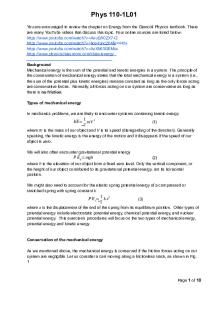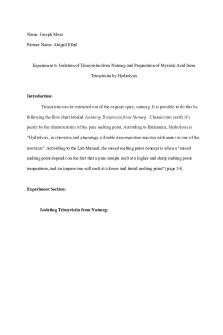Lab Report 5 - Airtrack PDF

| Title | Lab Report 5 - Airtrack |
|---|---|
| Course | General Physics With Calculus I |
| Institution | Valencia College |
| Pages | 3 |
| File Size | 171.8 KB |
| File Type | |
| Total Downloads | 15 |
| Total Views | 126 |
Summary
This is Lab Report 5 for Airtrack for Physics I with Calculus. It has all of the correct answers and they are all explained thoroughly. ...
Description
Lab Report 5: Airtrack April 1, 2018 Introduction The following experiment explores the conservation of momentum and energy in a closed physical system and to explore the governing dynamics of the one-dimensional, two-body problem on a frictionless surface. Procedure 1. Put a flag and male contact needle on the first glider and weigh it. 2. Attach the female contact to the2nd glider and weight it, then add on the masses for case 2 and case 3. 3. Turn the Air Supply on and then place the two gliders on the track opposing one another as shown in the diagram. 4. Place one glider in between the two photogates (this one is to remain stationary), and place the other at one of the ends so that the needle and cork are facing one another (this one will be pushed). 5. Connect the Photogates into the Photogate Ports on the 850 Interface, and also connect the USB cable to the computer’s USB port. 6. Open the Capstone software and select Hardware Setup. 7. Click the each of the two small holes on the digital version of the Photogate port on the computer, and then select Photogate. 8. Then select Timer Setup: a. Click on Preconfigured Timer and click Next twice b. Click on Two Photogates (Single Flag) and click Next twice c. Input the length of the flag which is approximately 0.1 m, and the distance between the Photogates which 0.5 meters is recommended. 9. Then click on the Table and Graph 10. On the first table, select Speed in Gate 1 and on the second table, select Speed in Gate 2. 11. Make sure the Airtrack is level. 12. Position the stationary cart (without the flag) past the first photogate so that it is far enough for the cart with the flag to completely pass through the photogate before the collision occurs. 13. On the computer click RECORD and with very little force push the cart with the flag through the photogate. After it has passed the second photogate, on the computer click STOP before it comes through the photogate a second time. (Don’t let the glider bounce through the second photogate again, make sure to click STOP). 14. Record your data points for each run on the provided table.
15. Use the experimental data to determine the weight of the masses on the second glider. 16. Weigh the masses and calculate the percent error. Materials Listing ● ● ● ● ● ● ● ●
Air Supply Vacuum Hose Air Track Glider x2 Air Track Kit Photogate and Stand x2 850 Interface Laptop
Results Mass of Glider, Flag, Needle (m 1 ):_______.19880 _ _______________ kg Mass of Glider, Cork (m 2 ):_____________.18960 _ ____________________ kg V2 :_____________0_____________________ m/s Table 1 Velocity Readings
Velocity of m 1 through Photogate 1 (v1 ) (m/s)
Velocity of mTotal through Photogate 2 (vnew) (m/s)
NO masses on second glider (case 1)
.11
.07
2 masses on second glider (case 2)
.15
.07
4 masses on second glider (case 3)
.13
.05
Table 2 Momentum Calculations
Momentum of m 1 Momentum of m2 before collision before collision (N*s) (N*s)
Momentum of mTotal after collision (N*s)
NO masses on second glider
.02187 0
.02719
2 masses on second glider
.02982 0
.03424
4 masses on second glider
.02584 0
.02948
Case 2 mmasses = ___________.10744____________ kg Case 3 mmasses = ___________.20138____________ kg Case 2 mactual = ___________.10073__________________ kg Case 3 mactual = ___________.20125__________________ kg Percent Error:_____________3.34%______________
Conclusion By looking at the data recorded and the error margin, we can begin to understand how conservation of momentum works. This demonstrates the successful predictability of the law. Further experimentation with better resolution of equipment will most likely reveal the trend of momentum conservation and provide a valid basis for which it can be used to explain the world and predict outcomes....
Similar Free PDFs

Lab Report 5 - Airtrack
- 3 Pages

LAB 5 - Lab report
- 4 Pages

Lab Report 5 - lab
- 5 Pages

Lab 5 - Lab report
- 6 Pages

Lab 5 - Lab experiment report
- 6 Pages

Lab 5 Lab Report- (Microbiology)
- 4 Pages

Phys lab 5 - Lab report
- 10 Pages

Experiment 5 - Lab Report 5
- 16 Pages

Post Lab Report Lab 5
- 5 Pages

Lab 5 Report
- 5 Pages

Chem lab report 5
- 7 Pages

Lab 5 Report
- 8 Pages

EX 5 lab report
- 10 Pages

Lab Report 5
- 8 Pages

Lab Report 5
- 16 Pages

Lab report 5
- 13 Pages
Popular Institutions
- Tinajero National High School - Annex
- Politeknik Caltex Riau
- Yokohama City University
- SGT University
- University of Al-Qadisiyah
- Divine Word College of Vigan
- Techniek College Rotterdam
- Universidade de Santiago
- Universiti Teknologi MARA Cawangan Johor Kampus Pasir Gudang
- Poltekkes Kemenkes Yogyakarta
- Baguio City National High School
- Colegio san marcos
- preparatoria uno
- Centro de Bachillerato Tecnológico Industrial y de Servicios No. 107
- Dalian Maritime University
- Quang Trung Secondary School
- Colegio Tecnológico en Informática
- Corporación Regional de Educación Superior
- Grupo CEDVA
- Dar Al Uloom University
- Centro de Estudios Preuniversitarios de la Universidad Nacional de Ingeniería
- 上智大学
- Aakash International School, Nuna Majara
- San Felipe Neri Catholic School
- Kang Chiao International School - New Taipei City
- Misamis Occidental National High School
- Institución Educativa Escuela Normal Juan Ladrilleros
- Kolehiyo ng Pantukan
- Batanes State College
- Instituto Continental
- Sekolah Menengah Kejuruan Kesehatan Kaltara (Tarakan)
- Colegio de La Inmaculada Concepcion - Cebu